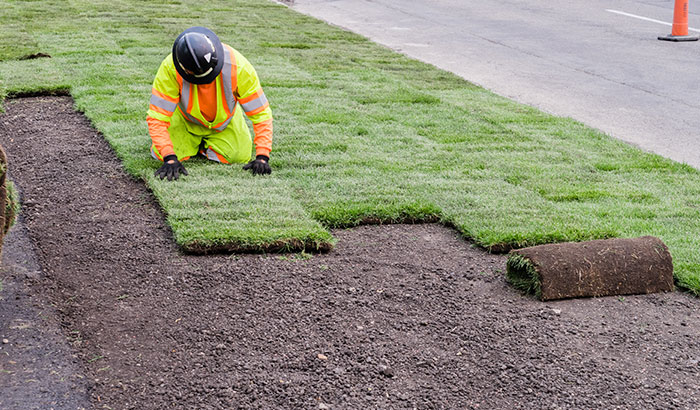Proper sod installation and fertilization are crucial to developing a beautiful, green grass lawn that lasts for years to come. If you’re planning to install a new lawn or replace an existing one, there are some essential things you need to know to do it right.
This article will discuss the steps involved in sod installation and fertilization to help you create a lawn you’ll be proud of.
Preparing for Sod Installation
Before installing sod, it’s crucial to prepare the area adequately to ensure the new lawn takes root and thrives. The first thing you need to know is the amount of sod you’ll need. Measure the area and determine how much sod it will take to cover your lawn.
Once you know how much sod you need, prepare the soil by removing grass, rocks, or debris. Tilling the ground will help accomplish this; tiling to a depth of at least six inches loosens the soil and allows the roots of the new sod to penetrate the ground.
After tilling, it’s important to level the soil and create a slight slope away from buildings or other structures to prevent water from pooling. After the ground has been tilled, add additional components to the soil to ensure that the soil is rich in nutrients and has the proper pH level for optimal growth.
Installing the Sod
Once the soil is adequately prepared, it’s time to install the sod. Sod installation is a tough job, and most people hire professionals to do it. If you decide to install the sod yourself, it’s essential to lay the sod immediately upon delivery to avoid it drying out.
Start by laying the sod along the longest straight edge of your lawn and work your way back and forth, staggering the seams like bricks. After laying the sod, it’s crucial to water it thoroughly to ensure the roots make contact with the soil. The sod should be watered deeply, but not to the point where standing water is present.
Sod installation cost varies depending on the size of the area, the type of sod, and whether you hire professionals or do it yourself. However, the benefits of a green, healthy lawn are well worth the cost. We recommend talking with a professional to get an accurate estimate of what your sod installation cost may be for your yard.
Sod Fertilization
Once you have your sod installed, you’ll want to make sure you have green grass for years to come. Fertilizing your lawn is essential for providing nutrients to help your grass grow lush and green.
The type of fertilizer you use for grass fertilization will depend on various factors. The type of sod you install, the soil type, and the time of year can all affect the type of fertilizer you should use to keep your grass green and healthy. We recommend talking to the people installing your sod to figure out the best kind of fertilizer for your lawn.
It’s also important to fertilize your lawn at the right time and to use the proper amount. Knowing how much fertilizer to use can be confusing for most homeowners, as the instructions are usually given in pounds of nitrogen per 1000 square feet. If you aren’t sure how much you should use, ask a professional for their opinion; you don’t want to over-fertilize or under-fertilize.
With grass fertilization, it’s important to factor in the sod installation cost and budget accordingly. Grass fertilization is crucial to keeping your green grass healthy and growing.
Maintaining your Lawn
After the initial sod installation and fertilization, maintaining your lawn is crucial to keeping it healthy and looking great.
This goes without saying, but one of the most important things you need to do after installing sod is to water it. The amount of water required is going to depend on how long the sod has been installed.
Sod should be heavily watered the first day, as it needs a chance to start the rooting process before it dries out. For the first few days after installation, sod should be watered a few times a day. After the first week, you can start watering it once a day or as needed based on your location and weather.
Another crucial aspect of lawn maintenance is mowing. You should wait for the sod to fully take root before mowing (usually two to three weeks). Mowing at the right height and frequency can help keep your lawn healthy by preventing weed growth and encouraging thicker grass.
Lawn aeration is another maintenance task that can help alleviate soil compaction and allow nutrients and water to penetrate the roots more effectively.
Lastly, controlling weeds and pests is essential to maintaining a healthy lawn. Applying herbicides and pesticides at the right time can help prevent weeds and pests from taking over your yard. Following a consistent maintenance routine can keep your lawn looking great all season long.
Troubleshooting
Even when it seems as though you’ve done everything right, issues can still come up with your newly installed sod. Some common problems include yellowing grass, bare spots, and pest infestations.
If you notice a problem with your lawn, you should try to identify the cause. Once you know what’s wrong with your lawn (over-fertilization, under-watering, foot traffic, or lack of sunlight, for example), you can take steps to fix the problem.
To ensure that problems don’t stem from the sod installation process, we recommend letting a professional take care of the installation process.
Choose Monarch Sod for a Beautiful Lawn
If you’re looking for professional help with sod installation, Monarch Sod is here to help. Let us take the stress out of sod installation so that you can sit back and enjoy a lush and healthy lawn.
Don’t let the challenges of sod installation discourage you from achieving the lawn of your dreams. Contact Monarch Sod today at 801-623-6701 or visit our website to learn more about our services and how we can help you create the lawn you’ve always wanted.












